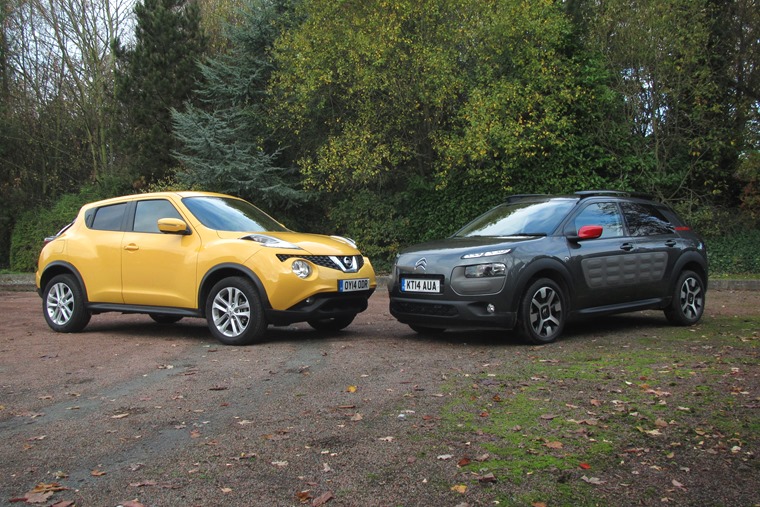Crossover crunch time: Citroen C4 Cactus v Nissan Juke
Nissan’s jaunty Juke came to define the kooky crossover segment in 2010 but a refreshed model earlier this year arrived about the same time Citroen launched its C4 Cactus rival.
Any crossover aiming to make an impression lives or dies by its left-of-centre looks and the Cactus is no different with its Airbump side panels giving the Citroen a truly unique and striking appearance.
We’ve already reviewed the C4 Cactus in isolation but how does it compare when sat next to the Juke?
Skip to:
Exterior – Interior - On the road - Running costs - Verdict
Exterior
John Simpson says: Touching those Airbumps is the natural urge of anyone seeing the C4 Cactus for the first time. They’re not as satisfying as popping a sheet of bubblewrap but these oblong plastic bubbles are soft enough to push in easily but robust enough to bounce right out again.
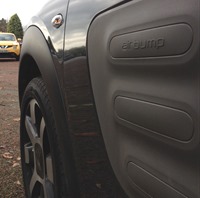 The idea is that they’ll protect against the kind of scratches and scuffs commonly picked up in car parks. Runaway trolleys, neighbouring drivers wildly swinging their car door open, rabid dogs; these replaceable plastic panels can stand up to plenty of abuse.
The idea is that they’ll protect against the kind of scratches and scuffs commonly picked up in car parks. Runaway trolleys, neighbouring drivers wildly swinging their car door open, rabid dogs; these replaceable plastic panels can stand up to plenty of abuse.
They also look pretty cool and it’s refreshing that such a major design feature is backed up with a valid practical purpose.
Add in sharp ski-like roofbars, slitty headlights from the C4 Picasso and a variety of perky colour combinations and the C4 Cactus is definitely an attention-grabber. The back end isn’t as exciting or inspired though.
The Juke’s talent for dividing opinion hasn’t weakened post-facelift, even if the changes are barely noticeable, and I sit firmly on the ‘yes’ side of the fence.
I love the frog eyes, the swooping coupe roof, its physical and metaphorical eye-popping audacity; it offends people but as I’m not one of them, I can’t get enough.
Both cars are truly unique in the looks department, but my love for the Juke is too strong.
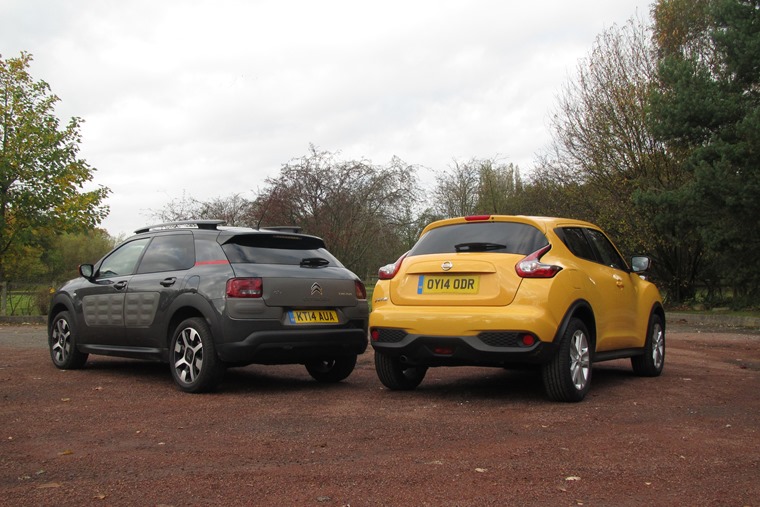
James Fossdyke says: I sort of understand anyone who says they prefer the Juke in this department because it’s different without being too radical, but I’m afraid it doesn’t do it for me.
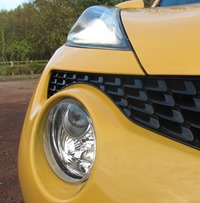 I don’t like the pronounced headlights. Or the frog-like looks.
I don’t like the pronounced headlights. Or the frog-like looks.
People want the Juke to stand out in a crowd, but these days it’s so common that nobody bats an eyelid, even when it’s painted bright yellow.
The Cactus, however, with its Airbumps and the narrow daytime running lights, re-writes the book on design. Everyone who passes you on the motorway has to have a look-see.
Citroen’s offering doesn’t just beat the Juke at its own game, though. I think it’s generally a stronger design with style as well as substance.
Some won’t like the Airbumps, even if they are a really good idea, but I’m less convinced by the roof bars, which won’t be used much but add drag. Perhaps making them optional would have been a better move.
Interior
John says: Another victory for Juke here, even if it is slightly conflicted.
The Nissan’s cabin isn’t as spacious as the Citroen’s, despite being wider and taller on the outside, and key features like cupholders are awkwardly placed.
However, the Juke’s dark fabric seats and cool balance of black plastic and flat chrome across the dashboard and steering wheel makes the Juke the better looking cabin for me.
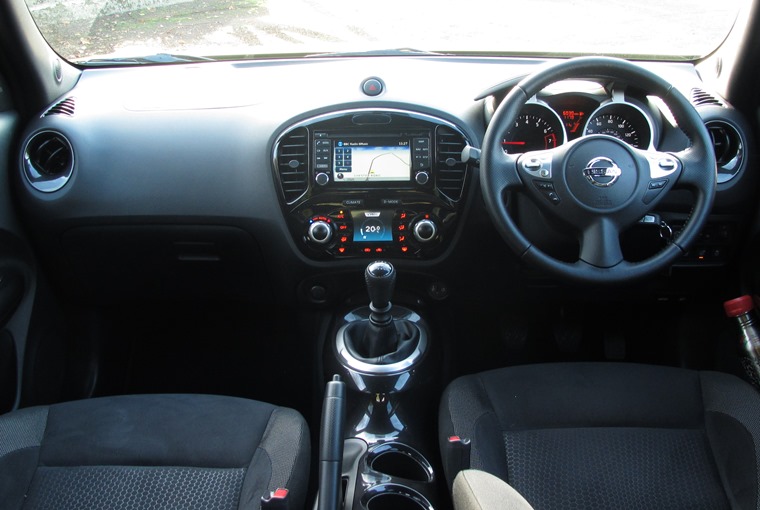
The Juke’s infotainment system is more user-friendly than the Citroen’s less responsive touchscreen system which still feels fiddly a year after it appeared in the Peugeot 308. Too many button presses to do what you want and sometimes the system won’t register the command. Aesthetically tidy but practically flawed.
Speaking of buttons, the C4 Cactus’ steering wheel is covered in them. Rather than follow the minimal approach of the DS3, it’s taken cues from the C4 Picasso on this front. The flat topped steering wheel is a nice touch but the banquet of buttons is a turn-off.
It’s in contrast to the Juke’s tidier steering wheel which uses the same switches you’ll find in the Qashqai and Leaf.
The Citroen’s level dashboard and flat glovebox is a nice touch as are the leather door handles, however three years and 30k miles may not leave them in great shape.
The lack of a rev counter in the Cactus was a bit annoying, it’s true not everyone uses it but not everyone doesn’t and it’s handy for gear changes and knowing if the stop/start has kicked in.
James says: John and I can’t agree on this one, because for me it’s the Cactus that takes the honours with a more stylish, more modern, more practical layout.
I know some of the plastics are a bit hard, I really wish there was a rev counter and why Citroen thought integrating the heater controls into the touchscreen was a good idea is beyond me, but otherwise it’s well thought out, well built and really roomy.

The big armchairs that pass for seats and the huge glass roof (a £395 option on all but the basic Touch model) are great touches too.
In the Juke, however, it’s a different story. The plastics are thin as well as hard, the switchgear feels fragile and cheap (air conditioning controls, I’m looking at you), the ergonomics are all wrong and the displays between the speedo and rev counter look quite outdated, as does the touchscreen.
At least the Juke is rammed with kit like sat nav and air conditioning, even on this lower-spec Acenta model. I’m a big fan of the Around View Monitor (a £400 option on this car) which provides a top-down view of the car and its immediate surroundings.
The Cactus isn’t spartan though, with a reversing camera, automatic lights and wipers and satellite navigation.
It’s also more spacious, offering a slightly larger boot than the Juke’s and a bit more room across the rear bench in terms of head and leg room. The black headlining in our test Juke only made it feel smaller.
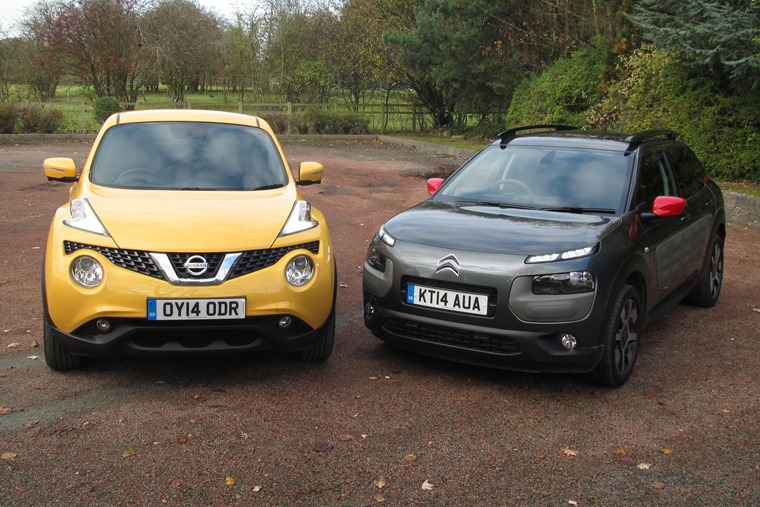
On the road
James says: Again, I have to go with the Cactus, if only because it’s much clearer on what it’s trying to do.
Though the 108bhp three-pot petrol engine gives the Citroen a bit of get-up-and-go, it’s no sports car. The gearbox has a long throw and even longer gearing, while the soft springs make it more than a little wallowy through the bends.
Instead, the car is much more about a cushy ride and fuel economy.
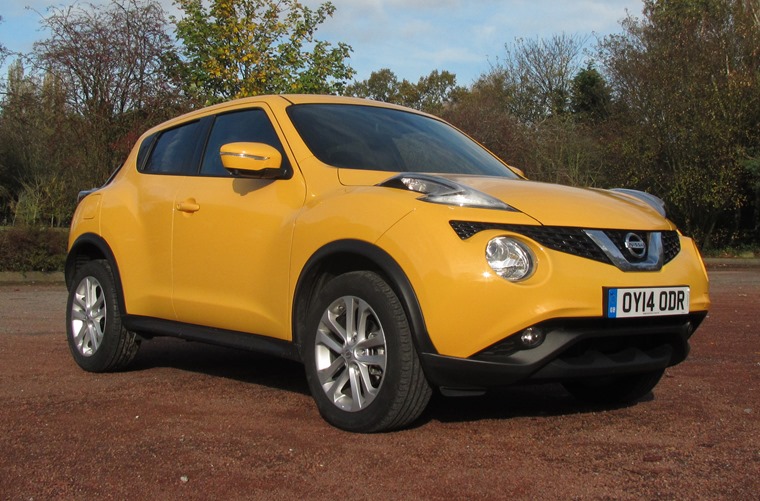
The Juke, on the other hand, has made an effort to be a bit sportier and therein lies its undoing.
Stiffer springs are intended to make it handle better and they sort of work, but any pretence of sportiness is quashed by the ride height, the body roll, the notchy gearbox and, in the case of the 1.2-litre DIG-T petrol shown here, the breathless engine. In the end, all the suspension really does is ruin the ride.
Despite appearances, neither car can cut it over the rough stuff, with the Cactus denied it by the DS3 platform it sits on and the Juke offering all-wheel drive only if you go for the thirsty 1.6-litre petrol engine and an automatic gearbox. And you’ll have to pay at least £20,000.
John says: After claiming the first two bouts, this is where the Juke starts to let slip and it’s a biggie.
The C4 Cactus’ ride is notably softer and comfier than the jerky Juke which can be tough going over long journeys with its rigid ride and for high mileage drivers, it’s no contest; the Citroen is the only choice.
The Juke’s handling has more rewarding feel with a greater level of feedback to the comparatively lifeless Cactus. There’s nothing in it for straight line acceleration with 0.1 of a second separating the two but I find the Citroen’s gutsier low end torque to be more rewarding.
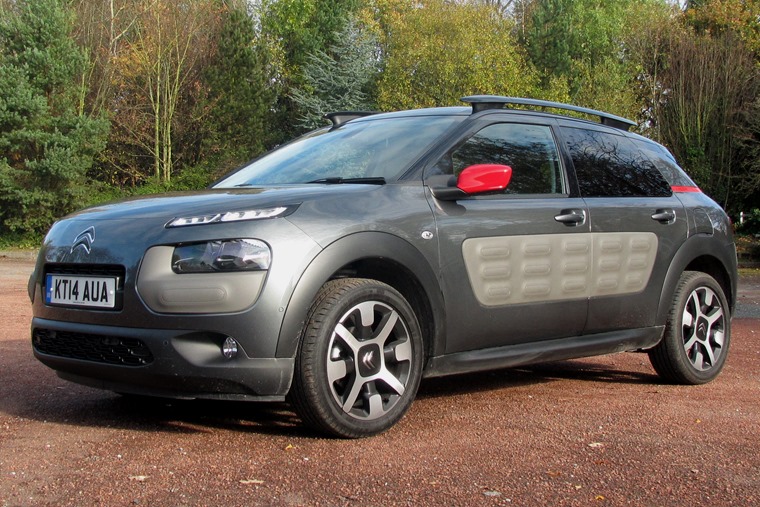
Both cars are equally leaky on the NVH front. Plenty of wind and road noise oozes into the cabin and neither car is better than the other in terms of delivering a peaceful drive.
Running costs
The Juke is slightly pricier, with OTR prices starting from £13,420, rising to over £21,000, whereas the Cactus starts from £12,990 and you’ll struggle to pay much more than £20,000, even if you go mad with the options list.
Lease deals, though, start from around £140 per month for the Citroen, but Juke deals can go below the £100 mark.
For the cars on test, however, the biggest difference lies under the bonnet, where the Cactus had a 99bhp, 1.6-litre diesel while the Juke took a 1.2-litre DIG-T petrol with 113bhp. Unsurprisingly, the Cactus is cheaper to run. Officially, it’ll do 83mpg (91mpg with 15in wheels), while the petrol-powered Juke only manages 47mpg.

The Juke’s also more polluting, emitting CO2 at a rate of 129g/km – 40g/km more than the Cactus. Strangely, the Cactus is also faster, hitting 62mph 0.1 seconds faster than the Juke.
As a result, this Nissan is subject to 18% BIK tax for company car drivers, but the Cactus undercuts it with just 14%.
Of course, the Juke is offered with a more competitive 1.5-litre diesel, which manages 70mpg and 104g/km, which equates to 16% BIK. That’s an improvement, but it still leaves the Juke a fair way behind the Citroen.
The verdict
John says: This is a true head and heart battle. Admittedly, I’m in a minority when it comes to admiring the Juke’s jaunty looks. There’s still nothing that looks quite like it and although the same can be said for the bubbly Cactus, the Citroen’s silhouette isn’t nearly as distinctive.
If that’s what you want from a car then the Juke is going to win out no matter what.
However from a value point of view and choosing a practical, comfortable but distinctive car which is cheap to run, the Cactus has to be the winner.
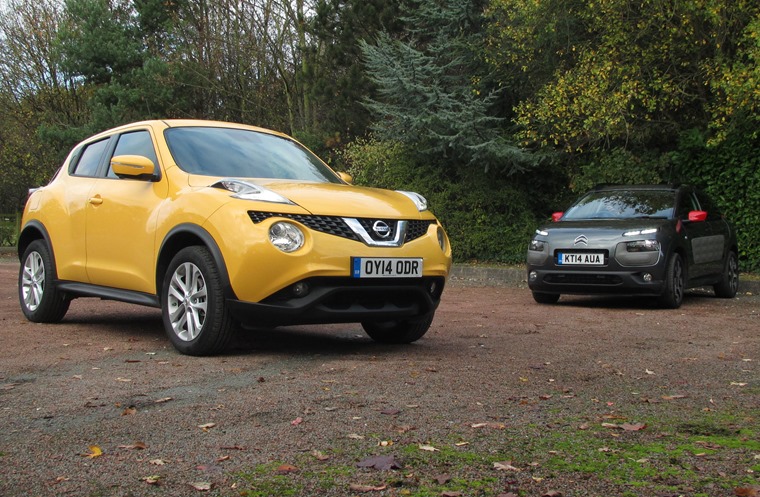
James says: It’s tough to look beyond the Cactus in this face-off. It has a bit more interior space, I prefer the styling inside and out and it’s much more efficient. I can’t believe I’m saying this about a French car, but I think it’s better built, too.
The only reason you’d acquire the Juke – and there are plenty of people who have – is because you like the way it looks. It’s all about the image.
Unfortunately for the little Nissan, it’s not an image I want to portray, certainly not at the expense of comfort, driving dynamics, build quality, space and fuel economy.
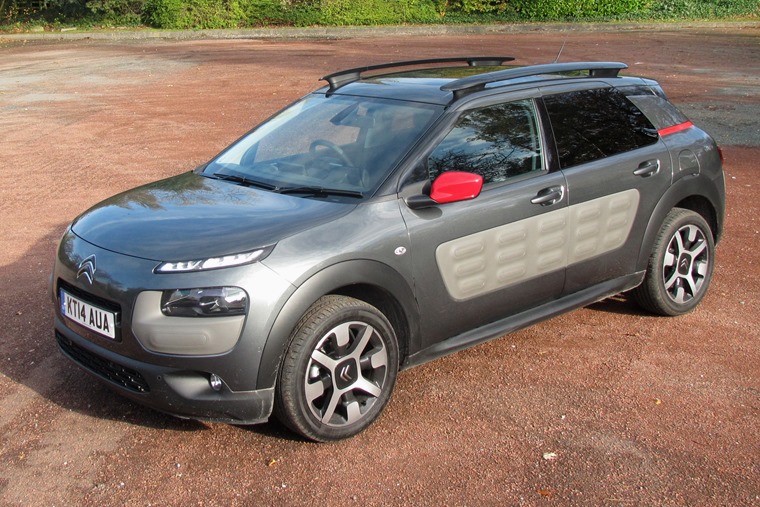
*Leasing prices quoted are business deals, all prices correct at time of writing
